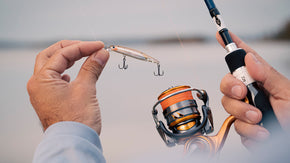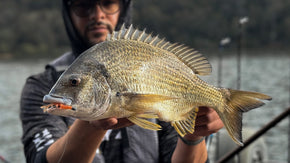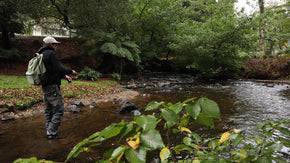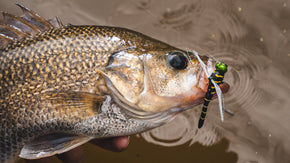Posted 19th February 2025
When is the best time to go fishing?


By Robert Thornton
Working in a tackle shop there are a handful of questions we get asked regularly, especially from those just starting out. By far one of the most common ones is, “when is the best time to go fishing?”
A reasonable question, sure, but not one that can be answered simply. While there are preferable times to hit the water in most angling scenarios, they are still dependent on a variety of factors. In other words, the best fishing time is a subjective thing.
In this blog we’re going to dissect those factors and give you the tools to work out the peak bite times in your neck of the woods. Hopefully, the information below will help you to maximise your time on the water and ultimately, catch more fish!
Let’s jump right in.
How long is a piece of string?
Asking when’s the best time to go fishing is kind of like asking the length of a piece of string – there are many answers to that question, and all of them are probably true in some way!
A better question might be something like “when is the best time chase xspecies in yspot?” This is a more refined approach, one that takes into account that different species have different habits, and that the fishing can vary from spot to spot.
To delve deeper, you could ask something like, “when is the best time to chase xspecies in yspot at ztime of year?” A question like this addresses key variable factors like species, location and season, and this is exactly what keen newcomers need to do to maximise their fishing.
Unfortunately, there is no cheat code, and the only real way to answer that question is to do some research and reconnaissance, as well as trial and error. Figuring these things out is all part of the fun of fishing and makes landing that trophy fish all the more rewarding!

Know your target
It can be hard determining the hot bit period if you don’t know what lives there, and this is why the best anglers tend to have a target species for each session. It doesn’t always have to be a single species, but by narrowing your search to the few species you’re likely to encounter in that area, you’re already giving yourself a good start.
There are many ways to find this information, with books, internet articles and online videos all helpful resources. With that said, nothing is as good as actually going fourth and engaging the real world, which means asking staff at local tackle stores, and even chatting to and observing anglers at the location if there are any.
Once you know what you’re chasing, you’ll need to learn about the species. Once again, there is so much information available for a wide variety of species. This website, for example, has nearly a dictionary’s worth of content on popular sportfish, with all of it produced by anglers. A blog I did on bream fishing would be a good start if you wanted to learn about bream, for example. The knowledge passed on through these resources helps build a picture of when the best fishing times might be in your area. Knowing what they like to eat in different parts of the country, how tidal movements and times of day might affect this, as well as how the seasonal patterns play into it is all foundational when targeting specific fish.
General, common-knowledge stuff like this can be applied to specific populations of a species in a particular location, but it doesn’t have to end there. One of the most exciting things about fishing is how fish behaviour adapts to suit the environmental conditions. Basically, what this means is no two locations are ever exactly the same, and this is where you have no choice but to put your boots on and discover it for yourself!
Location, location, location
Location is probably the most important factor of all when working out peak bite times, with the physical geography of a place and how the elements interact with it ultimately what determines fish behaviour.
The elements in question here are things like light level (time of day), tides, wind, air and water temperature, natural disasters and so on.
In tidal zones, the tide is probably the most important factor of all, with season and time of day usually coming in close behind. In freshwater or non-tidal locations, season and time of day are the two things to be focussing on.
Keep in mind that some areas can be a bustling hive of fish activity for short periods at a certain stage of the tide, time of day (usually sunrise or sunset) or even as floodwater concentrates food in that particular spot. Outside these times, the spot could be completely desolate, or even high and dry with no water at all! This is why it’s so important not to discount a spot without observing it under a variety of conditions.

Boots on the ground
I’m going to connect the dots by using my land-based bream fishing sessions in the Brisbane River as an example. These days I have a handful of spots I like to ‘run-and-gun’ with the car, bike or via public transport, and as the tide pushes up the river, I’ll work my way upstream with it. In doing so, I’m intercepting the bream as they start feeding in each location. After about 15-20 minutes the bite usually slows, and I’ll jet further upstream to catch that same crucial stage of the tide at the next spot.
I mapped out this ‘milk run’ through observation and trial-and-error. By sitting on the bank and just watching, I gradually worked out that the bream would chase small prawns into the shallows during the last half hour of the incoming tide, however once it reached high, the action would slow down. I actually discovered this by accident while out walking along the river one afternoon!
I always encourage customers and readers to visit a location without any fishing tackle and just watch what’s going on. I like to work these ‘study sessions’ into things I am already doing, like walking along the river with my girlfriend, or driving a certain route to work that takes me over a creek I’m interested in. You may even notice things by chance, like I did, which is why I always keep my eyes peeled when I’m close to water.
If you’re really serious, you may even want to do recon during rain or other uncomfortable conditions. If this sounds like you, Daiwa’s Rainmax Stretch Jacket and Stretch Pantswill keep you and your pocketed items dry while you scope a potential fishing spot. A good weather-proof pack is handy as well, especially for things like phones, cameras, binoculars, note pads and so on. Daiwa’s Guide series, with the Guide Backpack, Guide Waist Bag and Guide Phone Pouch are ideal for the serious reconnaissance artist, and even fit together in a bag-on-bag system!
Back to the bream journey, it wasn’t until the trial-and-error stage where I discovered how time of day also affected the fishing. I noticed that the fish were more willing (or rather, less gun shy) to eat my lures when that stage of the tide coincided with sunrise or sunset. Clearly, these urban bream prefer the cover of lowlight (but not complete darkness) to hunt.
As time went on, I also found that my best sessions occurred in late summer and early autumn, roughly in step with the prawn run in my part of the world.
Lessons learnt
Using just this example, you can see how I was able to work out the best fishing times for bream in my specific locations. With research, observation, and trial-and-error, I found that the last half hour of the incoming tide was the most important thing, and without that the bream simply wouldn’t be there.
Low light periods also helped, though weren’t necessary, but if I could find a favourable tide phase at sunrise or sunset, I would make an effort to be on the water then.
This knowledge allows me to focus my bream fishing around these specific times, ensuring I’m not spending valuable fishing time fishing in areas where fish aren’t. Outside these times, I can chase other species in other locations!
Found time
One concept that really changed my perspective is thinking of spare time as ‘found time’. Treating it this way allows you to find creative ways to use it, and learning about the aquatic world is my favourite way to spend found time!
The real answer to the title question should actually be, “whenever you have the time!” Whenever I have time, I usually reading about a spot I’m interested in, or down at that spot trying to work out what lives there, or even fishing in one of my regular spots to learn something new.
Spending time at a spot is the only real way to work out when the best fishing times will be. Once you’ve done the hard yards, you can organise your busy schedule around these windows and spent more of your fishing time actually catching fish!
Good luck!
















